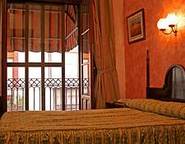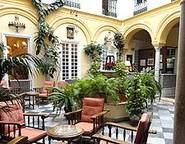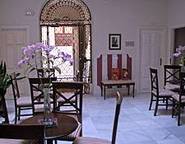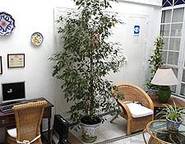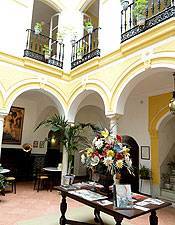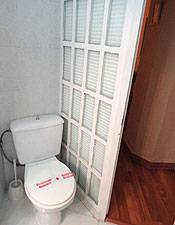Cheapo Kari scouted hotels in Seville just before the Easter festivities. See what she has to say about the hotel scene, best times to travel and must-do activities.
Reviewing Seville

1. Budget tip.
Southern Spain swelters in the summer, which means that hotels offer their cheapest rates in August, and some also offer free breakfast. The weather in spring and fall is much more pleasant—with more expensive room rates to match.
2. What surprised you about the city’s hotels?
They are built to beat the heat! Sevillanos figured out the importance of cross breeze hundreds of years before the air conditioner was invented, and the tiled courtyards are filled with foliage and water fountains. I was particularly impressed with the working fountain at the Hotel Don Pedro, which is located in a building that belonged to the Civil Guard during Franco's reign.
While inside, I kept mis-gauging how hot it was outside because the indoor spaces were so cool. That said, July, August and September are still brutal in southern Spain. But, for people who love the heat and the best room rates of the year, it’s the place to be.
3. What trends did you notice?
Twins! Everywhere. Seville is a city of twins. Odd.
The Metropol Parasol architecture project at Plaza de la Encarnacion has been a major source of controversy. Architects debate its design sense, and locals wonder if it was worth the money. Regardless, the undulating structure is visually overpowering—all the more so for the Roman ruins that were found under the construction site. Tip: Some of the best views can be had at the cool (and cheap) Oasis Backpacker’s Hostel.
Easter. I read all about it before visiting, but the impact of Seville’s Easter traditions is so much more powerful in person. While flitting from hotel to hotel, I kept having to stop for groups of men walking through the streets with a plank of metal the size of car on their shoulders, practicing for the big day.
4. Must-do activity
Visit the fabric stores. Seville is famous for its lace, and most Sevillanos sew their own wedding and flamenco dresses. That means the fabric stores are packed with bolts of lace and bold polka dot, striped and checked fabrics.
Ceramics are also big in Seville, and Triana, the neighborhood across the river from city center, is great for ceramics shopping.
Another must-do is, of course, flamenco, and you don’t have to pay for a ticket in an official theater. The music is alive in the streets and bars throughout the city. My friend and I stayed at the Hotel Simon and woke in the middle of the night to the taps of flamenco shoes on the street outside of our balcony. To get even more up-close-and-personal with the dance, stay at the Hotel Alcántara, which shares its building with a flamenco salon.
5. Fun (or quirky) souvenir.
I bought a little nazareno figurine in a pastry shop and took him everywhere for good luck. Nazarenos are the hooded men who march in the Easter processions. Even though the costumes do resemble the robes of modern klansmen (many locals felt the need to clarify, “no es KKK”), these hooded figures march for penance, and have been doing so for hundreds of years.
Read all of Kari's reviews of cheap Seville hotels.

